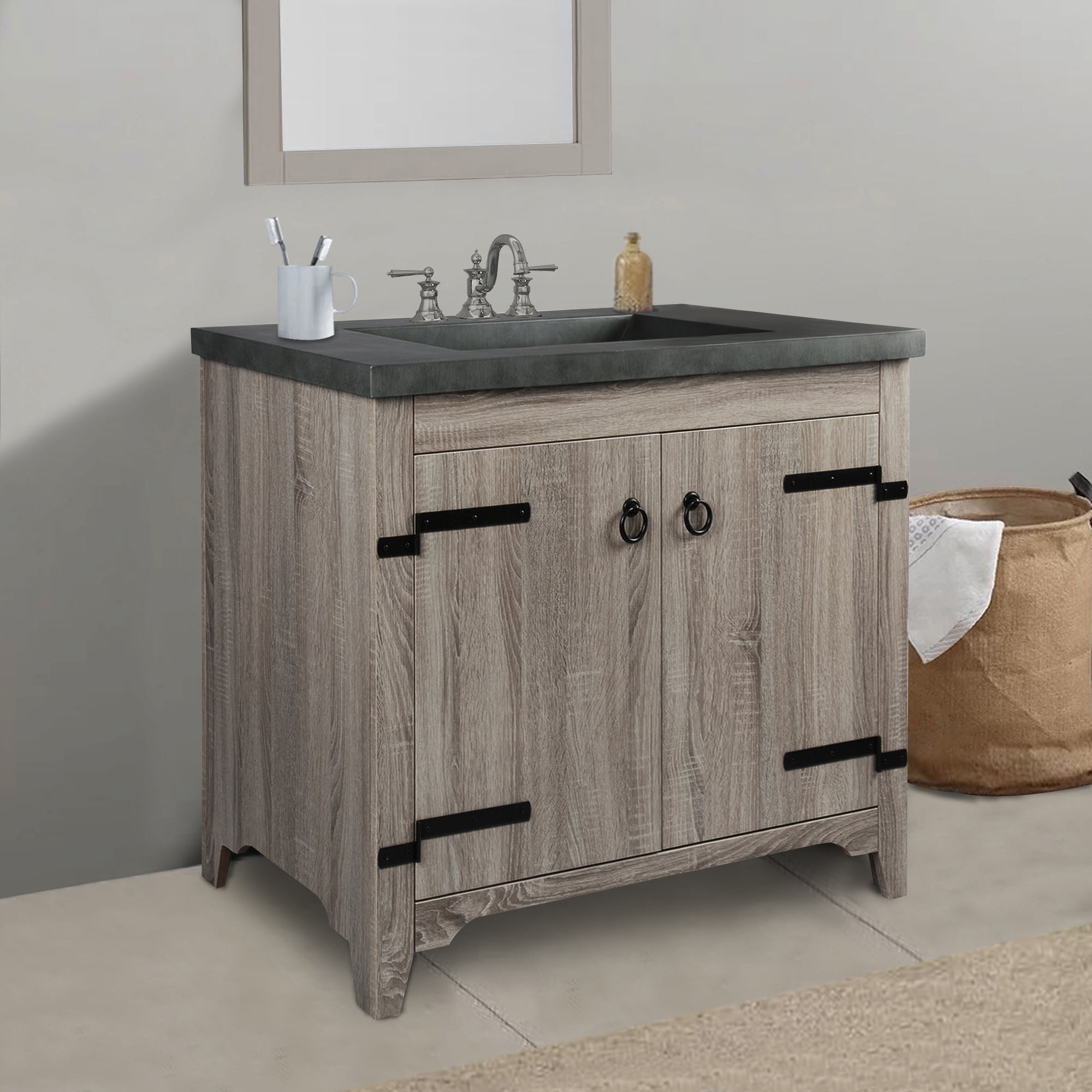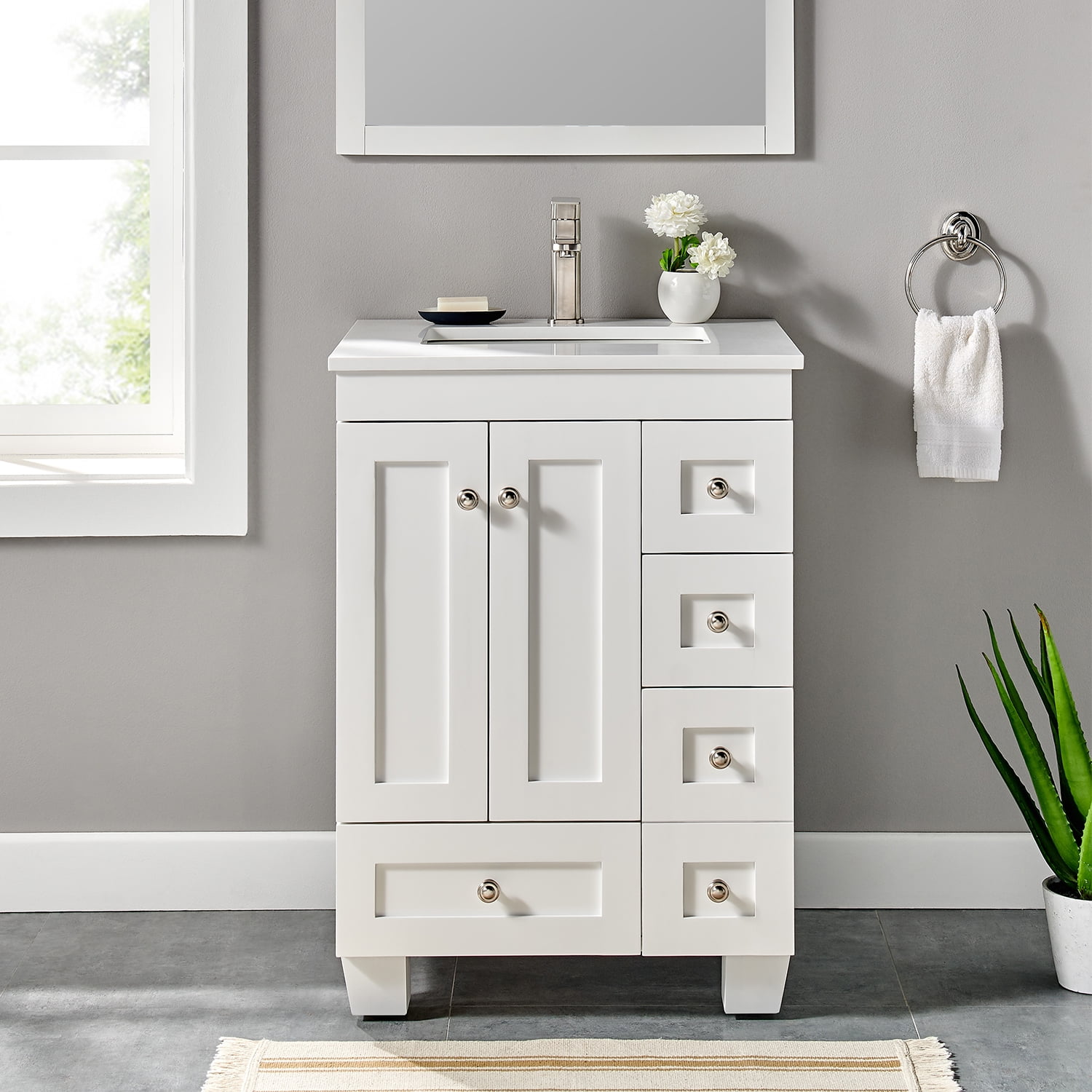Understanding the 26-inch Wide Bathroom Vanity: 26 Wide Bathroom Vanity

A 26-inch wide bathroom vanity is a popular choice for smaller bathrooms or powder rooms, offering a compact solution without sacrificing functionality. This type of vanity provides ample storage space for toiletries and essentials, while still maintaining a sleek and modern aesthetic.
Typical Features of a 26-inch Wide Bathroom Vanity, 26 wide bathroom vanity
26-inch wide bathroom vanities typically feature a single sink, offering sufficient space for everyday use. They often include cabinets with drawers and shelves, providing ample storage for toiletries, towels, and other bathroom essentials. Some models also include a mirror, while others require separate mirror installation.
Pros and Cons of a 26-inch Wide Bathroom Vanity
- Pros:
- Space-Saving: A 26-inch wide vanity is ideal for smaller bathrooms, maximizing space and minimizing clutter.
- Affordable: Compared to larger vanities, 26-inch wide models are often more affordable, making them a budget-friendly option.
- Versatile: They can be incorporated into various bathroom styles, from traditional to modern.
- Easy to Install: Their compact size makes them relatively easy to install, even for DIY enthusiasts.
- Cons:
- Limited Storage: The smaller size limits storage capacity compared to larger vanities, requiring careful organization.
- Limited Counter Space: The countertop may be small, potentially limiting the amount of space available for toiletries and other items.
- Not Ideal for Large Families: For families with multiple members, a 26-inch wide vanity may not offer enough storage or counter space.
Examples of 26-inch Wide Bathroom Vanity Styles
- Modern: Modern 26-inch wide vanities often feature sleek lines, minimalist designs, and high-quality materials such as stainless steel or polished chrome.
- Traditional: Traditional vanities typically have ornate details, such as carved wood accents and antique-inspired hardware.
- Farmhouse: Farmhouse vanities often incorporate rustic elements like reclaimed wood, distressed finishes, and farmhouse-style hardware.
- Contemporary: Contemporary vanities embrace clean lines, geometric shapes, and neutral color palettes, creating a modern and sophisticated look.
Choosing the Right 26-inch Wide Bathroom Vanity

Selecting the perfect 26-inch wide bathroom vanity is a crucial step in designing your dream bathroom. This size offers a practical balance between functionality and space-saving efficiency, especially for smaller bathrooms. But with numerous options available, it can be overwhelming to choose the right one.
Comparing 26-inch Wide Bathroom Vanities
Understanding the differences between various 26-inch wide bathroom vanities is essential for making an informed decision. This table compares popular options based on price, materials, features, and style:
| Vanity | Price Range | Materials | Features | Style |
|---|---|---|---|---|
| Traditional Wooden Vanity | $500 – $1,500 | Solid wood, natural stone countertop | Double sinks, storage drawers, open shelves | Classic, elegant, often with ornate details |
| Modern Acrylic Vanity | $300 – $800 | Acrylic, laminate countertop | Single or double sinks, minimalist design, sleek lines | Contemporary, clean lines, often with integrated sinks |
| Industrial Metal Vanity | $400 – $1,200 | Metal frame, wood or laminate countertop | Open shelving, industrial-style hardware, distressed finishes | Rustic, edgy, often with exposed metal accents |
| Farmhouse Vanity | $450 – $1,000 | Wood, farmhouse-style sink, distressed finishes | Single or double sinks, open shelving, farmhouse-inspired hardware | Rustic, charming, often with a distressed white finish |
Considerations for Choosing a 26-inch Wide Bathroom Vanity
Choosing a 26-inch wide bathroom vanity requires careful consideration of various factors. Here are some key aspects to keep in mind:
- Bathroom Size: A 26-inch wide vanity is ideal for small bathrooms, providing adequate counter space without overwhelming the area. However, ensure sufficient clearance around the vanity for comfortable movement.
- Storage Needs: Consider your storage requirements. A vanity with drawers and shelves offers ample storage for toiletries, towels, and other bathroom essentials. If you have limited storage space, look for a vanity with a mirror cabinet.
- Personal Preferences: Your personal style should guide your choice. Do you prefer a traditional, modern, industrial, or farmhouse aesthetic? Choose a vanity that complements your bathroom’s overall design and reflects your taste.
Designing a Bathroom Layout with a 26-inch Wide Vanity
A 26-inch wide bathroom vanity can be seamlessly integrated into a variety of bathroom layouts. Here’s an example of a compact bathroom design featuring a 26-inch wide vanity:
Layout: Imagine a small bathroom with a single window. The 26-inch wide vanity is positioned against the wall opposite the window, creating a focal point. A large mirror above the vanity visually expands the space. A compact shower stall is placed adjacent to the vanity, maximizing space efficiency.
Fixtures: A sleek, chrome-finish faucet is mounted on the vanity countertop. A small towel rack is placed next to the vanity, providing convenient access to towels. A small storage cabinet is placed above the toilet, providing additional storage for toiletries.
Decor: A small, decorative plant adds a touch of nature to the space. A stylish rug adds warmth and comfort to the bathroom floor. The walls are painted in a soft, neutral color, creating a calming ambiance.
Installing a 26-inch Wide Bathroom Vanity

Installing a 26-inch wide bathroom vanity is a relatively straightforward process that can be done by most homeowners with basic DIY skills. It’s a project that can significantly enhance the look and functionality of your bathroom.
Tools and Materials Needed
Before you begin the installation process, ensure you have all the necessary tools and materials. This will help you complete the project efficiently and avoid unnecessary delays.
- Level: A level is essential for ensuring that the vanity is installed straight and even.
- Tape measure: A tape measure is crucial for accurately measuring the space where the vanity will be installed and cutting the plumbing lines if needed.
- Stud finder: A stud finder helps you locate the wall studs to secure the vanity properly.
- Pencil: A pencil is needed for marking the location of the vanity on the wall and for any other necessary markings.
- Drill: A drill is essential for drilling pilot holes and attaching the vanity to the wall.
- Screwdriver: A screwdriver is needed for securing the vanity’s hardware and other components.
- Wrench: A wrench is needed for tightening the nuts on the plumbing lines and for any other necessary adjustments.
- Plumber’s tape: Plumber’s tape is used to seal the threads on the plumbing lines to prevent leaks.
- Caulk: Caulk is used to seal any gaps between the vanity and the wall, preventing water damage.
- Safety glasses: Safety glasses protect your eyes from debris and other potential hazards during installation.
- Work gloves: Work gloves protect your hands from cuts and scrapes.
Steps for Installing a 26-inch Wide Bathroom Vanity
Here is a step-by-step guide for installing a 26-inch wide bathroom vanity:
- Prepare the Area: Before you begin the installation process, clear the area around the existing vanity or the location where you will install the new vanity. Remove any obstacles, such as towels, toiletries, and other items, to create a clear workspace.
- Turn off the Water Supply: Before you disconnect any plumbing lines, turn off the water supply to the bathroom. This will prevent water damage during the installation process.
- Disconnect the Plumbing: Disconnect the water supply lines from the existing vanity or the plumbing lines that will be used for the new vanity. Make sure to use a wrench to tighten the nuts on the plumbing lines to prevent leaks.
- Remove the Existing Vanity: If you are replacing an existing vanity, carefully remove it from the wall. Be sure to remove all screws and hardware. If the vanity is heavy, you may need to ask for assistance.
- Prepare the Wall: Clean the wall area where the vanity will be installed. Remove any dirt, debris, or old caulk. Make sure the wall is level and smooth. If necessary, use a drywall patch to repair any damage.
- Locate the Wall Studs: Use a stud finder to locate the wall studs where the vanity will be installed. This is important for ensuring that the vanity is securely attached to the wall.
- Mark the Location: Use a pencil to mark the location of the vanity on the wall. Make sure the vanity is centered and level. If you have a double sink vanity, make sure the sinks are centered and level.
- Install the Vanity: Carefully lift the vanity into place and align it with the markings on the wall. Use a level to ensure that the vanity is level and straight. Secure the vanity to the wall using screws that are long enough to reach the wall studs.
- Connect the Plumbing: Connect the water supply lines to the vanity. Make sure to use plumber’s tape to seal the threads on the plumbing lines to prevent leaks. Tighten the nuts on the plumbing lines using a wrench. Ensure that the lines are properly connected and secure.
- Caulk the Gaps: Use caulk to seal any gaps between the vanity and the wall. This will prevent water damage and enhance the look of the vanity.
- Install the Hardware: Install the vanity’s hardware, such as the sink, faucet, and mirrors. Make sure to follow the manufacturer’s instructions for installation.
- Test the Plumbing: Turn on the water supply and test the plumbing lines for leaks. If you find any leaks, tighten the nuts on the plumbing lines or use plumber’s tape to seal the threads.
- Clean Up: Once the vanity is installed and the plumbing is tested, clean up the area around the vanity. Remove any debris or tools.
Tips for Proper Installation
Here are some tips for ensuring proper installation and avoiding common mistakes:
- Measure twice, cut once: Make sure to accurately measure the space where the vanity will be installed before you begin cutting any plumbing lines. This will help you avoid making mistakes that can be difficult to fix.
- Use a level: Use a level to ensure that the vanity is installed straight and even. This will help you avoid a crooked or uneven vanity.
- Secure the vanity to the wall studs: Secure the vanity to the wall studs using screws that are long enough to reach the studs. This will ensure that the vanity is securely attached to the wall and prevent it from falling over.
- Use plumber’s tape: Use plumber’s tape to seal the threads on the plumbing lines to prevent leaks. This is an important step that can save you a lot of headaches in the long run.
- Caulk the gaps: Use caulk to seal any gaps between the vanity and the wall. This will prevent water damage and enhance the look of the vanity.
- Test the plumbing: Test the plumbing lines for leaks after you install the vanity. This will help you identify and fix any problems before they become bigger issues.
